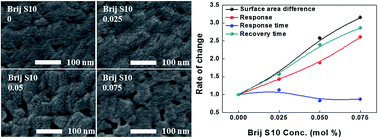Enhancement of the O2 gas sensing properties of mesoporous Sr0.9La0.1TiO3 films by increasing the pore connectivity
Abstract
The structural and gas sensing properties of mesoporous Sr0.9La0.1TiO3 films for oxygen sensing applications were investigated as a function of surfactant concentration. Through the synthesis of Sr0.9La0.1TiO3 with a mesoporous structure, the surface area and pore connectivity were increased by increasing the surfactant concentration. Using a thermal treatment, interior pores were exposed to the surface thereby increasing the surface area. This increase in surface area induces an increase in oxygen absorption, which results in an enhanced oxygen sensitivity. The oxygen sensing properties of mesoporous Sr0.9La0.1TiO3 films were analyzed at an oxygen concentration of 30% and an analysis temperature of 550 °C. The results at these conditions showed the maximum oxygen sensitivity (9.43), response time (38 s), and recovery time (181 s). The inclusion of a surfactant during the preparation of mesoporous films was found to be a simple and effective method to enhance the surface area and interior pore connectivity of the films to enhance their gas sensing performance.


 Please wait while we load your content...
Please wait while we load your content...